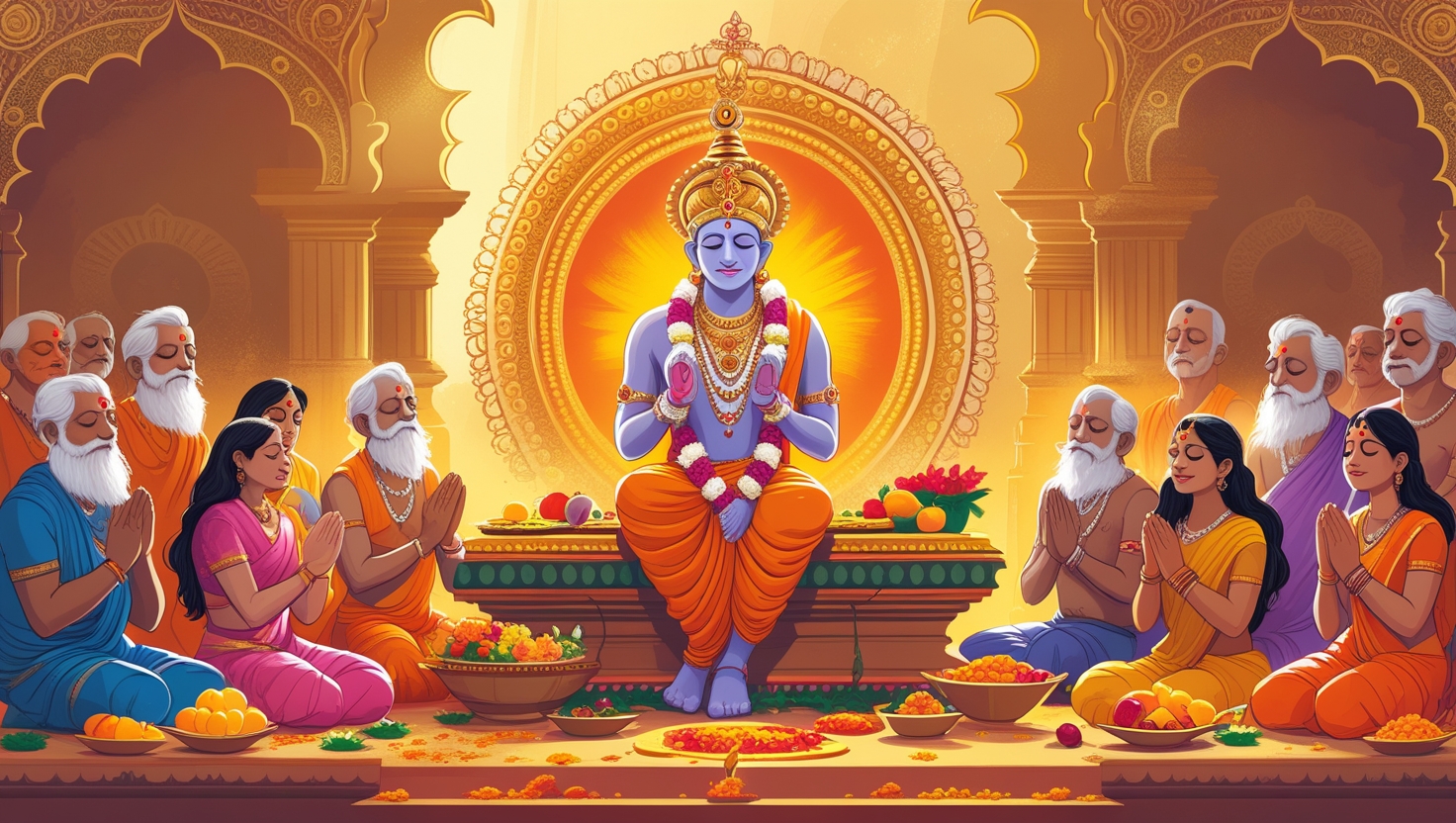The Satyanarayan Katha is an integral part of Hindu traditions, cherished for its spiritual importance and the lessons it imparts through religious stories. This sacred ceremony, often performed at home, involves narrating the story of Lord Satyanarayan, a manifestation of Lord Vishnu. The ritual is believed to bring prosperity, peace, and well-being to practitioners. As devotees gather to perform the puja, they partake in spiritual practices that foster a sense of community and devotion.
Historical Origins of Satyanarayan Katha

The Satyanarayan Katha is a deeply revered ritual in Hindu traditions, celebrated for its spiritual and religious significance. Understanding its historical origins gives insight into how this sacred practice has evolved and spread over centuries. The origins of the Satyanarayan Katha are shrouded in antiquity, believed to be embedded in ancient Sanskrit texts. Primarily, it finds mention in the Skanda Purana, one of Hinduism’s major texts. This Purana is composed of numerous legends and stories offering moral lessons and spiritual teachings. The Satyanarayan Katha itself consists of stories that underscore the virtues of truth and devotion. The term ‘Satyanarayan’ refers to a form of Lord Vishnu, the preserver of the universe according to Hindu beliefs. In the Katha, Lord Vishnu appears as Satyanarayan, symbolizing the embodiment of truth.
Essential Items for Satyanarayan
Satyanarayan Katha Samagri
- Red Cloth – 1/2 meter.
- Yellow Cloth – 1/2 meter.
- White Cloth – 1/2 meter.
- Elaichi – 10 grams.
- Loung – 10 grams.
- Attar (Perfume) – 5 ml
- Aggarbati (Incense Sticks)
- Matti Diya (Clay Lamp) – 1 unit
- Betel Nut (Supari) – 11 pieces
- Batasha (Sugar Candy) – 15 grams
- Janeu (Sacred Thread) – 1 piece white, 1 piece yellow
- Moli (Holy Thread) – 1 unit
- Roli (Red Powder) – 15 grams
- Turmeric Powder – 15 grams
- Sindoor (Vermilion) – 15 grams
- Kapoor (Camphor) – 10 grams
- Sandalwood paste – 10gm
- Honey – 15 ml
- Ghee (Clarified Butter) – 25 ml
- Rice
- Sugar – 15 grams
- Panchmeva (Assorted Dry Fruits) – 15 grams
- Panchamrit (a sacred mixture of milk, yoghurt, honey, ghee, and sugar)
- Sapt Mirittika (Seven Soils) – 1 unit
- Ganga Jal (Water from River Ganges) – 30 ml
- Dry Coconut – 1 piece
- Pure Cow Ghee Diya Batti – 11 pieces
- PMatchbox – 1 box
- Fruits – 5, 7 or 9 pieces
- Tulsi(Holy Basil) and Flowers
Satyanarayan Puja Mantra
1. ध्यानम (Dhyanam):
- ध्यायेत् सत्यं गुणतितम गुणत्रयसमन्वितम्। लोकनाथं त्रिलोकेशं कौस्तुभभरणं हरीम्॥ नीलवर्ण पीतवस्त्रं श्रीवत्सपादभूषितम्। गोविंदं गोकुलानंदं ब्रह्माद्यैरपि पूजितम्॥
- Dhyayet Satyam Gunatitam Gunatrayasamanvitam। Lokanatham Trilokesham Kaustubhabharanam Harim॥ Nilavarna Pitavastram Shrivatsapadabhushitam। Govindam Gokulanandam Brahmadyairapi Pujitam॥
2. आवाहनम (मूर्ति के सामने खड़े होने पर) (Avahanam)
- दामोदर समागच्छ लक्ष्म्य सह जगत्पते। इमाम माया कृतं पूजं गृहाणा सुरसत्तमा॥ श्री लक्ष्मी सहिता श्री सत्यनारायणाय अवाहयामि।
- Damodara Samagachchha Lakshmya Saha Jagatpate। Imam Maya Kritam Pujam Grihana Surasattama॥ Shri Lakshmi Sahita Shri Satyanarayanaya Avahayami।
3. आसन (भगवान को आसन अर्पित करते समय) (Asana) :
- नानारत्न समाकीर्ण कर्तास्वरविभूषितम्। असनम देवदेवेश! प्रीत्यर्थं प्रतिगृह्यतम॥ ॐ श्री सत्यनारायणाय नमः आसनं समर्पयामि।
- Nanaratna Samakirna Kartasvaravibhushitam। Asanam Devadevesha! Prityartham Pratigrihyatam॥ Om Shri Satyanarayanaya Namah Asanam Samarpayami।
4. पंचमित्र स्नानम् (Panchamitra Snanam):
- स्नानं पंचामृतैरदेवा गृहाणा सुरसत्तमा। अनाथनाथ सर्वज्ञ गिर्वाना प्रणतप्रिय॥ ॐ श्री सत्यनारायणाय नमः पंचामृत स्नानं समर्पयामि।
- Snanam Panchamritairdeva Grihana Surasattama। Anathanatha Sarvajna Girvana Pranatapriya॥ Om Shri Satyanarayanaya Namah Panchamrita Snanam Samarpayami।
5.वस्त्रम (Vastram):
- शीतवतोष्णं समत्राणं लज्जायः रक्षणं परम्। देहलंकरणं वस्त्रं प्रीत्यर्थं प्रतिगृह्यतम॥ ॐ श्री सत्यनारायणाय नमः वस्त्र युग्मम समर्पयामि।
- Shitavatoshna Samtranam Lajjayah Rakshanam Param। Dehalankaranam Vastra Prityartham Pratigrihyatam॥ Om Shri Satyanarayanaya Namah Vastra Yugmam Samarpayami।
6. आरती (Aarti):
- चतुर्वर्ती समयुक्तं गोघृतेन च पुरितम्। अरार्तक्यमहं कुर्वे पश्य मे वरदो भव॥ ॐ श्री सत्यनारायणाय नमः मंगला आरतीम् समर्पयामि।
- Chaturvarti Samayuktam Goghritena Cha Puritam। Arartikyamaham Kurve Pashya Me Varado Bhava॥ Om Shri Satyanarayanaya Namah Mangala Aartim Samarpayami।
Symbolic Meaning of the Offerings
In the Satyanarayan Katha, each offering has symbolic meanings that enhance the spiritual experience:
– Flowers: Represent purity and devotion, offered to invoke the blessings of the deity.
– Fruits and Grains: Symbolize nourishment and prosperity, thanking the divine for sustenance.
– Incense and Lamps: Illuminate the altar, signifying the light of knowledge dispelling the darkness of ignorance.
– Panchamrit: A mixture of milk, yogurt, honey, sugar, and ghee, it signifies the sweetness and richness of life, used to anoint the deity and later distributed among participants.
Recitation Process and Sequence
1. Invocation and Prayer:
- The ceremony begins with prayers and the invocation of Lord Ganesh, the remover of obstacles, to ensure the ritual proceeds smoothly.
2. Sankalpa (Resolution):
- Participants take a collective vow to conduct the Katha with sincerity, expressing their intentions and seeking blessings.
3. Narration of Stories:
- The Katha consists of five key stories, each illustrating the supreme power of truth and devotion. These stories describe various scenarios where characters, by adhering to truth and devotion to Lord Satyanarayan, overcome difficulties and receive divine blessings.
4. Conclusion and Aarti:
- The recitation concludes with an aarti — a devotional song praising the deity while offering light from burning lamps. It signifies the end of the puja and the completion of the ritual.
5. Prasad Distribution:
- Devotees partake in ‘Prasad’ — sanctified food that includes the Panchamrit, as a token of divine blessings and communal sharing.
Lessons of Truth and Righteousness
One of the most profound teachings of Satyanarayan Katha is the significance of truth and righteousness. The name ‘Satyanarayan’ itself symbolizes the ’embodiment of truth.’ Devotees are taught the essence of living a life that aligns with the principles of honesty and integrity. Through the stories, the Katha emphasizes that truth, when upheld, ultimately leads to a fulfilling and peaceful life.
– Upholding Truth:
- The Satyanarayan Katha narrates various anecdotes where individuals who remained truthful in the face of adversity were eventually rewarded. It highlights the power of truth and encourages believers to maintain their moral compass even during challenging times. The stories teach that truth has its own way of triumphing, irrespective of the setbacks one might face initially.
– Practicing Righteous Living:
- Aside from advocating for truth, the Katha also underscores the importance of living righteously. It stresses that righteousness, or ‘dharma,’ is fundamental to achieving long-term happiness and spiritual growth. Through its tales, the Katha guides followers in avoiding deceit and cruelty, and instead encourages acts of kindness, compassion, and fairness towards all beings.
Stories of Devotion and Faith
The Satyanarayan Katha is rich with stories of unparalleled devotion and unwavering faith. Devotion, or ‘bhakti,’ is presented as a powerful force that connects the devotee with the divine. Faith in Lord Satyanarayan’s divine intervention plays a pivotal role throughout the narratives, offering comfort and hope to the believers.
– Devotees’ Experience:
- The Katha recounts the experiences of devotees whose lives were transformed through devotion and faith. These stories are a testament to the belief that divine blessings can manifest when one surrenders wholeheartedly to the Almighty. Be it the tale of a poor Brahmin or a destitute merchant, each narrative underscores that genuine devotion yields divine grace, and faith can indeed move mountains.
– Lessons on Humility and Gratitude:
- Through its stories, the Satyanarayan Katha teaches the importance of humility before God and gratitude for His blessings. It reminds devotees to approach the divine with a humble heart and express thanks for the grace received. This practice not only strengthens their spiritual connection but also fosters a sense of contentment and peace.
Transformation and Prosperity
Satyanarayan Katha isn’t solely focused on spirituality; it also brings attention to worldly transformation and prosperity. The tales narrated within this ritual serve as powerful reminders of how overcoming challenges through faith and morality can lead to personal transformation and material abundance.
The Satyanarayan Katha is rich with stories of unparalleled devotion and unwavering faith. Devotion, or ‘bhakti,’ is presented as a powerful force that connects the devotee with the divine. Faith in Lord Satyanarayan’s divine intervention plays a pivotal role throughout the narratives, offering comfort and hope to the believers.
– From Adversity to Prosperity:
- Many stories within the Katha depict characters who initially suffer from hardships or misfortune, only to later achieve prosperity through their devotion and adherence to truth. These tales illustrate that even amid dire circumstances, maintaining faith and virtue can pave the path to success and prosperity.
– Inner Transformation:
- Beyond material wealth, the Katha advocates for inner transformation. It encourages individuals to cultivate positive qualities like patience, perseverance, and self-discipline. By focusing on transforming inner consciousness, the Katha helps devotees aspire towards a higher state of being, resonating with both inner peace and holistic well-being.
Conclusion
The Satyanarayan Katha holds immense significance in Hindu traditions due to its deep spiritual teachings and moral lessons. Through its poignant stories and symbolic rituals, it offers a roadmap for living a life aligned with truth, righteousness, and devotion. For millions of followers around the world, this revered Hindu ritual is not only a practice of faith but also a means to achieve spiritual enlightenment and material prosperity.
By participating in such rituals, individuals are encouraged to reflect on their own lives with honesty, gratitude, and humility. The journey undertaken through Satyanarayan Katha is one of self-discovery and personal evolution, where followers emerge with a strengthened faith, enriched soul, and a renewed commitment to living in harmony with the divine principles of truth and righteousness.
For Read About Rudrabhishek– https://blog.thevedicpuja.in/significance-of-rudrabhishek/
For Read About MahaKumbh– https://blog.thevedicpuja.in/maha-kumbh-2025/
For Enquiry about Puja and Pandit, Click Here


